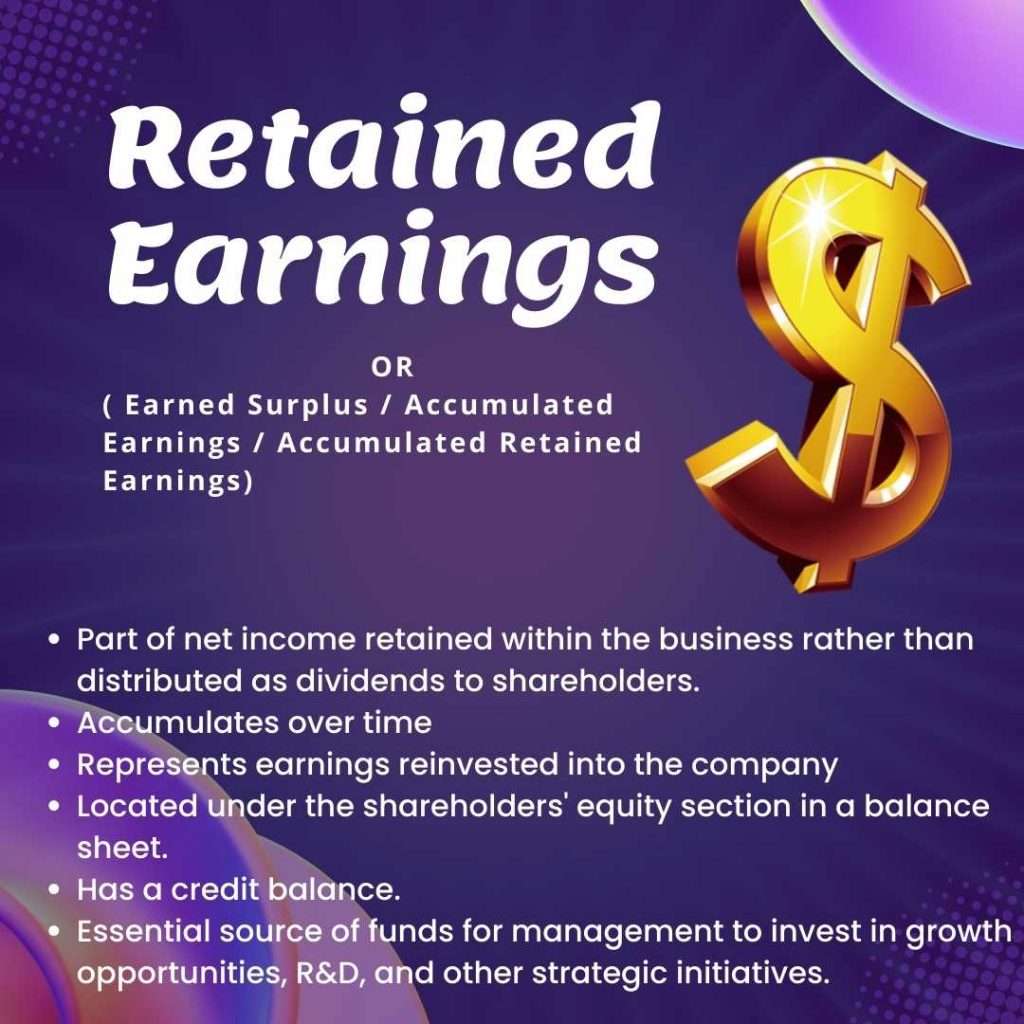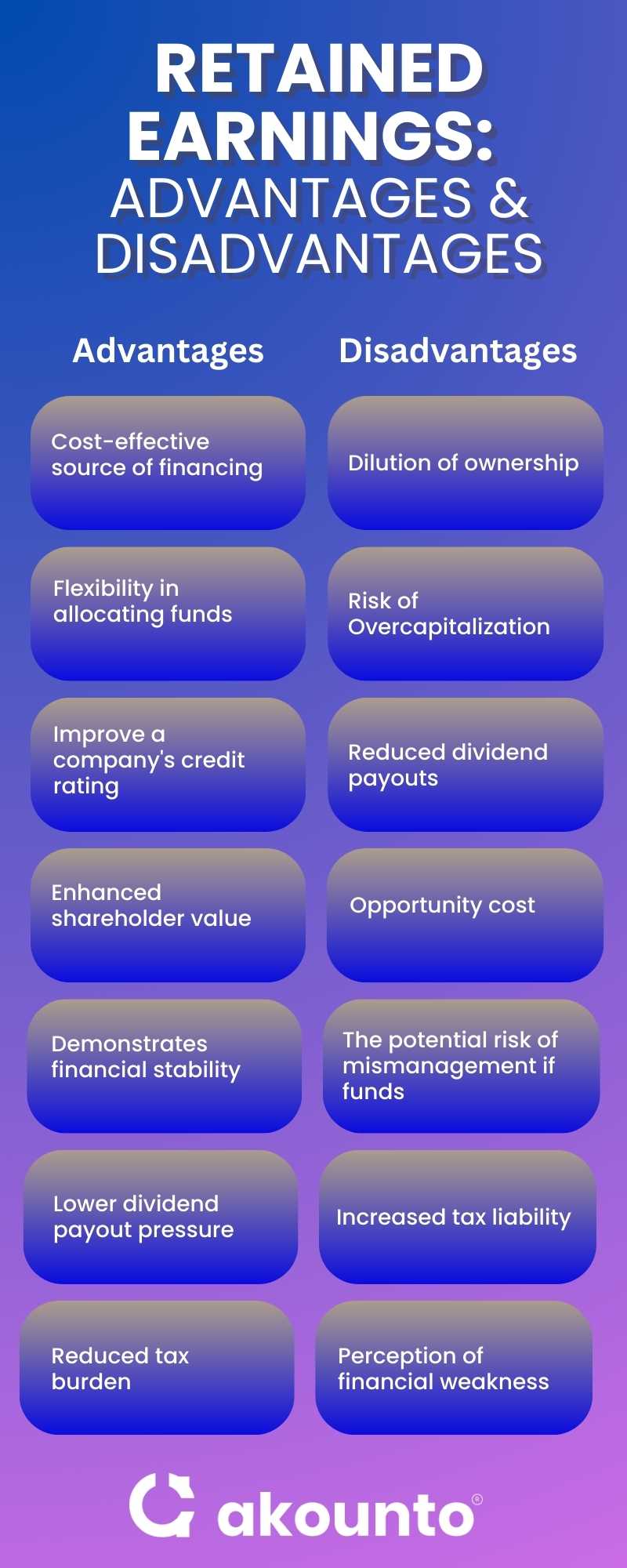Defining Retained Earnings
Retained earnings are part of net income retained within the business rather than distributed as dividends to shareholders.
This balance accumulates over time and represents the cumulative earnings reinvested into the company, thus also sometimes referred to as plowed-back profits or accumulated earnings).
What’s covered in the article
Retained earnings account can be located on a company’s balance sheet under the shareholders’ equity section, showcasing the accumulated net income (bottom line) that can be reinvested or retained rather than distributed as dividends.
This account typically has a credit balance, indicating positive earnings accumulation. By locating retained earnings account within the shareholders’ equity section, stakeholders can gain insights into the company’s financial stability, growth potential, and management of resources, making it a vital component for evaluating business performance.
Primary components of retained earnings (accumulated earnings) include:
- Beginning balance: This represents the retained earnings balance at the beginning of an accounting period. It is carried over from the previous accounting period and adjusted for any changes, such as dividend payments or prior period adjustments.
- Net income or loss: Net income is the company’s profit or loss for the current accounting period, calculated by subtracting operating expenses, cost of goods sold, and interest expenses from sales revenue. A positive bottom line increases retained earnings, while a net loss leads to a decrease.
Retained earnings (earned surplus) are essential for understanding a company’s financial health, reflecting the funds available for growth, capital expenditures, and other business investments.

Asset or Liability?
Retained earnings are an important financial element that can sometimes be misunderstood in classification. It is crucial to note that earned surplus are neither an asset nor a liability. Instead, they are found in the shareholder’s equity section of the balance sheet.
Shareholder’s equity, also called owner’s equity, signifies the residual interest in a company’s assets after deducting its liabilities. Earned surplus and other equity components, such as common stock and additional paid-in capital, contribute to shareholder equity.
Specifically, retained earnings represent the portion of net income (EAT: Earning After Taxes) that has been reinvested in the company instead of being distributed as dividends. This reinvestment supplies the business with resources to foster growth, expansion, and financial stability.
Read the article to learn more about the balance sheet treatment of retained earnings.
Significance
The importance of retained earnings cannot be overstated, as they play a crucial role in a company’s financial health and decision-making processes. The significance of accumulated earnings can be further explored through the following perspectives:
For Management
Retained earnings are an essential source of funds for management to invest in growth opportunities, research and development, and other strategic initiatives. They also provide a cushion for the company during economic downturns, allowing it to maintain operations and avoid taking on debt or seeking external financing.
For Investors and Creditors
Investors and creditors consider retained earnings to indicate a company’s financial performance and stability. A consistent increase in retained earnings may signal that the company is profitable and reinvesting its earnings, making it an attractive investment opportunity.
Conversely, a decrease or negative retained earnings balance can raise concerns about the company’s financial health.
For Tax Authorities
Retained earnings may also interest tax authorities, impacting the company’s tax obligations. In some jurisdictions, accumulated earnings are taxed lower than distributed dividends. Therefore, retaining earnings instead of distributing them as dividends can result in tax savings for the company.
Interpreting Retained Earnings
When examining retained earnings, it is important to consider various factors to accurately interpret their meaning in the context of a company’s financial health and performance. Here are some key points:
- Comparing with industry peers: Analyze retained earnings concerning industry peers to gain insights into how effectively the company manages its profits and reinvestments compared to competitors.
- Growth opportunities: A high retained earnings balance may indicate that a company has ample funds for future growth opportunities, expansions, or acquisitions.
- Dividend policy: Assess the company’s dividend policy to understand whether the earned surplus balance results from a strategic decision to reinvest profits or due to a lack of dividend payments.
- Financial stability: Analyze the company’s overall financial stability, including its debt levels and liquidity, to determine if the plowed-back profits are used effectively to support the business.
- Profitability trends: Examine the trends in profitability and net income over time to understand if the company is consistently generating profits contributing to accumulated earnings.
- Financial ratios: Utilize financial ratios, such as the return on equity (ROE) and the retained earnings to total assets ratio, to evaluate the efficiency of the company’s use of its earned surplus.
Considering these factors while interpreting accumulated earnings can provide a more comprehensive understanding of a company’s financial health and ability to utilize earned surplus effectively.
Formula and Calculation
Understanding the formula and calculation for retained earnings is essential for accurately determining a company’s financial position. The retained earnings formula can be expressed as follows:
Ending Retained Earnings = Beginning Retained Earnings + Net Income – Dividends Paid
Here is a breakdown of the formula components:
- Beginning Retained Earnings: This is the starting balance of retained earnings for an accounting period, typically found on the company’s balance sheet or retained earnings statement.
- Net Income: The company’s profit or loss during the accounting period can be found on the income statement. Net income (EAT) is calculated by subtracting operating expenses, cost of goods sold, and interest expenses from sales revenue.
- Dividends Paid: The number of dividends distributed to shareholders during the accounting period can also be found on the retained earnings statement.
To calculate retained earnings, follow these steps:
- Obtain the beginning retained earnings balance from the company’s balance sheet or retained earnings statement.
- Identify the company’s Earning After Taxes for the accounting period from the income statement.
- Determine the total dividends paid to shareholders during the accounting period.
- Apply the retained earnings formula to find the ending balance.
Example
Company A has provided the following information:
| Accounting Period | Beginning Retained Earnings | Net Income | Cash Dividends Paid | Stock Dividends Declared | Ending Retained Earnings |
| Year 1 | $100,000 | $60,000 | $20,000 | $5,000 | $135,000 |
| Year 2 | $135,000 | $75,000 | $25,000 | $10,000 | $175,000 |
Calculate the Retained Earnings.
Solution
| Accounting Period | Beginning Retained Earnings | + Net Income | – Cash Dividends Paid | – Stock Dividends Declared | = Ending Retained Earnings |
| Year 1 | $100,000 | + $60,000 | – $20,000 | – $5,000 | = $135,000 |
| Year 2 | $135,000 | + $75,000 | – $25,000 | – $10,000 | = $175,000 |
Factors Affecting Retained Earnings
Several factors can impact a company’s retained earnings balance, influencing its financial health and decision-making processes. Some of these factors include:
- Company’s net income: As a key component of the retained earnings formula, the company’s net income directly affects the earned surplus balance. Higher EAT will result in more retained surplus, while net losses will decrease the balance.
- Dividend policy: A company’s dividend policy can impact its retained earnings, as paying higher dividends will reduce the retained earnings balance while retaining more earnings will increase it.
- Operating expenses: Higher operating expenses can reduce EAT (earning after taxes) and, subsequently, the earned surplus available for reinvestment or dividend payments.
- Taxation: Tax laws and regulations can affect a company’s earned surplus balance, as they may influence the decision to distribute dividends or retain earnings for reinvestment.
- Business cycle: Economic fluctuations and business cycles can impact a company’s EAT, affecting its earned surplus. During periods of economic growth, companies may experience a higher bottom line and increased accumulated earnings, while economic downturns can lead to a lower bottom line and reduced earned surplus.
- Industry-specific factors: Certain industries may have unique factors influencing accumulated earnings, such as regulatory requirements, seasonal fluctuations, or technological advancements.
Relation between Net Income and Retained Earnings
- Direct impact: Net income directly impacts a business’s earned surplus, a crucial component of the calculation. An increase in EAT leads to higher retained earnings, while a decrease results in lower retained earnings.
- Business performance: Net income measures a company’s financial performance, influencing the amount of money generated and available for reinvestment or dividend payments. High net income often contributes to a more substantial earned surplus balance.
- Cash flow: The relationship between net income and retained earnings is essential in understanding a company’s cash flow. Positive EAT will increase cash inflow, while negative EAT may lead to a cash outflow, affecting the company’s financial health.
- Shareholders’ equity: Retained earnings are a component of shareholders’ equity, representing a company’s residual interest after deducting liabilities from assets. A higher net income increases accumulated earnings, contributing to greater shareholders’ equity.
- Dividend decisions: A company’s net income influences its ability to pay dividends. A company with high net income may distribute some of its earnings to shareholders, affecting retained earnings and the shareholders’ equity section on the balance sheet.
- Market price: The relation between net income and retained earnings can impact a company’s market price, as investors often use these financial measures to evaluate a company’s growth potential, profitability, and financial stability.
- Financial statement analysis: Understanding the relationship between net income and retained earnings is crucial when analyzing a company’s financial statements. This relationship can provide insights into the company’s financial health and ability to generate shareholder value.
By understanding the relationship between net income and retained earnings, businesses can make informed decisions regarding reinvestment, dividend payments, and overall financial strategy.
Positive Retained Earnings
- Indicate that a company has generated more net income than it has distributed as dividends over time.
- Reflect a company’s ability to reinvest earnings, grow the business, or pay down debt.
- It can enhance the company’s financial health and improve its credit rating.
- Attract investors, as they may view the company as financially stable and having growth potential.
Negative Retained Earnings
- Occur when a company has paid out more in dividends than it has generated in net income.
- This may indicate that a company is experiencing financial difficulties, leading to a negative balance in the retained earnings account.
- This can raise concerns among investors and creditors about the company’s long-term viability and financial stability.
- This may require the company to reevaluate its dividend policy, reduce expenses, or seek additional financing to improve its financial health.
Advantages
- Cost-effective financing: Retained earnings provide a cost-effective source of financing for business growth, as they do not require the payment of interest or fees associated with external financing options like loans or issuing new shares.
- Flexibility: Retained earnings offer businesses flexibility in allocating funds for various purposes, such as reinvestment, debt repayment, or expansion plans, without the restrictions that may come with external financing sources.
- Improved creditworthiness: A healthy retained earnings balance can improve a company’s credit rating, making it easier to obtain loans or other forms of financing at more favorable terms.
- Enhanced shareholder value: By reinvesting retained earnings into the business, companies can increase their overall value, resulting in higher share prices and better returns for shareholders.
- Financial stability: A strong earned surplus balance demonstrates financial stability, signaling to investors, creditors, and other stakeholders that the company can weather economic downturns or unexpected expenses.
- Lower dividend payout pressure: Companies with substantial retained earnings may experience less pressure to distribute high dividends, allowing them to focus on long-term growth and value creation.
- Tax efficiency: In some jurisdictions, retaining earnings can be more tax-efficient than distributing them as dividends, as dividend payments may be subject to double taxation (at the corporate and shareholder level).

Disadvantages
- Dilution of ownership: If a company consistently reinvests retained earnings instead of paying dividends, some shareholders may feel their ownership stake needs to be revised, as they are not receiving a return on their investment.
- Overcapitalization: A large accumulated earnings balance could lead to overcapitalization, where the company has more funds than necessary for its operations. This may result in inefficient use of resources and negatively impact the company’s overall performance.
- Reduced dividend payouts: Shareholders who rely on dividend income may be dissatisfied if a company consistently retains earnings rather than distributing them as dividends leading to a decrease in the company’s market value and shareholder dissatisfaction.
- Opportunity cost: Retained earnings may not always be the best option for financing business growth, as there could be more attractive external financing sources available that offer higher returns on investment.
- Potential mismanagement: A company with a large earned surplus may be at risk of mismanagement if funds are not allocated efficiently, or management pursues unprofitable ventures.
- Increased tax liability: In some jurisdictions, retaining earnings can result in higher tax liabilities for shareholders, as capital gains may be taxed at a higher rate than dividend income.
- Perception of financial weakness: In some cases, a high retained earnings balance could be perceived as a sign of financial weakness, particularly if the company is not using these funds to drive growth or improve its operations.
Conclusion
Retained earnings play a quintessential role in a company’s financial health, acting as a valuable source of internal financing from the beginning period of the business. These liquid assets can be used for reinvestment, debt repayment, or expansion, ultimately increasing the company’s asset value and net profit.
By effectively managing earned surplus, businesses can enhance their financial stability and drive long-term growth, optimizing their company’s cost management and revenue generation.











